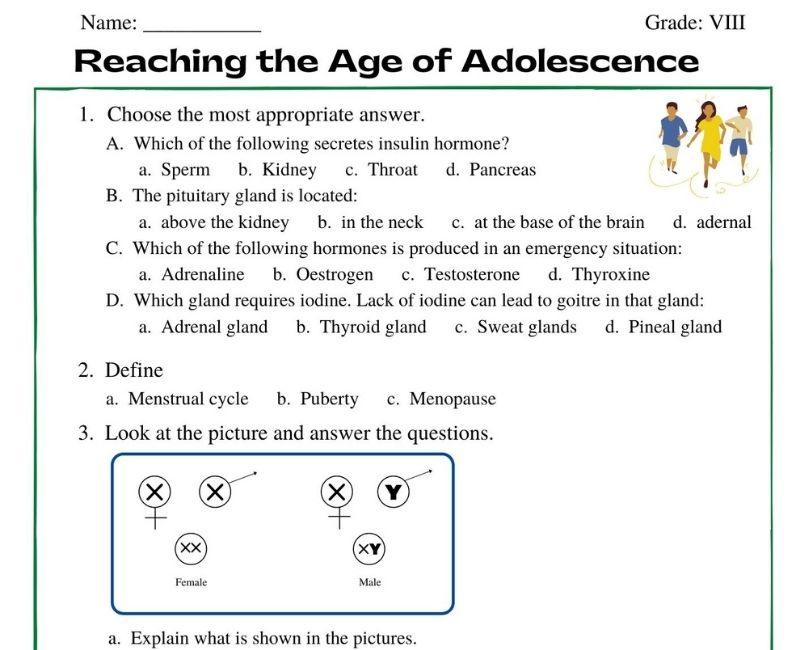Reaching The Age Of Adolescence Class 8 Worksheet
As students embark on the transformative journey of their developmental years, Reaching the Age of Adolescence emerges as a pivotal chapter in the curriculum for Class 8, encapsulated in Class 8 Science Chapter 7. This chapter not only demystifies the complexities of physical and emotional changes during the age of adolescence period but also equips young minds with essential knowledge about their growing bodies and minds. To reinforce these vital lessons, the Class 8 Reaching the Age of Adolescence Worksheet and the Reaching the Age of Adolescence Class 8 Worksheet serve as key educational tools, designed to engage students interactively and introspectively.
These worksheets delve deep into the biological and psychological transformations typical of adolescence. They challenge students not just to learn, but to connect personally with the information, fostering a deeper understanding and awareness of their own developmental stages. By tackling the Reaching the Age of Adolescence Extra Questions, students are encouraged to think critically and ask questions about how and why these changes occur, extending their learning beyond the conventional curriculum.
Moreover, Reaching the Age of Adolescence Notes provides a succinct, easy-to-understand breakdown of essential topics covered in the chapter, such as hormonal changes, the role of nutrition, and the importance of mental health during adolescence. These notes are invaluable as a quick reference for students, aiding in revision and solidifying their grasp of the subject matter.
Supplementing the theoretical aspects are the Reaching the Age of Adolescence Class 8 MCQs, which offer a methodical approach to testing the students' retention and understanding. Multiple-choice questions not only prepare students for examinations but also condition them to make precise and informed answers promptly.
In essence, as students navigate through the Reaching the Age of Adolescence Class 8th curriculum, engaging with these diverse and comprehensive educational resources, they gain a holistic understanding of this crucial phase of life. This journey through adolescence is not just about academic learning but about growing responsibly and healthily into well-rounded individuals.
Reaching the Age of Adolescence
Reaching the Age of Adolescence is a significant milestone in human development, marking the transition from childhood to adulthood. This period is characterized by rapid physical, emotional, and intellectual changes, driven by hormonal alterations within the body. Typically starting around the age of 11-12, this stage involves puberty, where secondary sexual characteristics develop, and individuals experience growth spurts, alongside cognitive advancements. Adolescents begin forming their identity, seeking independence, and developing a deeper capacity for abstract thinking and emotional complexity. It is a critical time for nurturing self-esteem and promoting a healthy lifestyle to support these profound transformations.
Reaching the Age of Adolescence Class 8 Worksheet
The Reaching the Age of Adolescence Class 8 Worksheet is a comprehensive educational resource, specifically tailored to aid students in understanding the profound changes they experience during adolescence. These worksheets feature a mix of activities, from labeling diagrams to interactive scenarios, all designed to elucidate the physiological and psychological aspects of puberty and maturation. Such worksheets not only enhance the learning experience but also guide students through self-reflection, enabling them to relate the academic content to their personal growth and development. By working through these practical exercises, students can grasp the complexities of adolescence with greater clarity and empathy.
Reaching the Age of Adolescence Extra Questions
Reaching the Age of Adolescence Extra Questions are curated to challenge students’ understanding beyond the standard curriculum. These questions provoke thought and discussion about the broader implications of puberty, social behavior, and emotional wellbeing during adolescent years. They often require students to apply their knowledge to diverse situations, promoting critical thinking and problem-solving skills. Through exploring these additional queries, students can deepen their comprehension of how adolescence affects not just themselves but also their peers and society. Engaging with these questions, learners become more informed and sensitive to the nuances of this transformative life phase.
Reaching the Age of Adolescence Notes
Reaching the Age of Adolescence Notes serve as a vital reference that encapsulates key information on the dynamic phase of human growth. These notes succinctly summarize the biological changes in reproductive systems, the significance of hormones, and the emerging social and emotional challenges faced by adolescents. They provide clear definitions, explanations, and examples that aid in revision and study consistency. With these notes, students can quickly review essential concepts and theories, enabling them to retain a clear understanding of the subject matter, which proves beneficial during lessons, assessments, and personal introspection.
Reaching the Age of Adolescence Class 8 MCQ
Reaching the Age of Adolescence Class 8 MCQs are a crucial component of the evaluation process, providing a fast-paced and effective method to assess students' knowledge on the subject. These multiple-choice questions test understanding of key concepts such as hormonal changes, reproductive health, and socio-emotional adjustments during adolescence. The focused nature of MCQs reinforces content retention and helps students identify areas where they might need additional study or clarification. Through regular practice of these MCQs, students can sharpen their test-taking skills, increase their confidence, and solidify their grasp of the nuances of adolescence.






